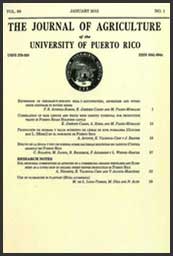Abstract
The effects of adding exogenous enzymes on the intake and digestibility of dry matter (DM) and on nutrients, and several blood parameters were determined in lambs fed a basal diet of 34% ground corn, 40% tropical grass hay, and 26% soybean meal providing 21% dietary starch. Twelve crossbred lambs (22 kg) were assigned to one of four diets: no additives (1); diets containing α-amylase (2); protease (3); or their combination (4). Diets (DM basis) were offered daily at 4% of animal BW in four 28-day experimental periods each consisting of 21 d of adaptation to the diet followed by 7 d of complete fecal collection. In each period, feed offered, orts and feces were collected, quantified and analyzed for contents of DM, starch, crude protein (CP) and neutral detergent fiber (NDF) to determine intake and digestibility. At the end of each experimental period, blood samples were collected from the individual lambs to determine the concentration of glucose, beta-hidroxy butyrate (BHB), nonesterified fatty acids (NEFA), and insulin. Data were analyzed according to a 4 x 4 Latin Square experimental design. Dietary treatment contrasts were performed using least square means adjustment for multiple comparisons (Tukey-Kramer) as follows: enzymes versus no enzymes, amylase versus no amylase and protease versus no protease. Dry matter intake was similar across treatments (1,106; 1,088; 1,105 and 1,088 g/d for control, and diets containing α-amylase, experimental protease or their combination, respectively). Adding protease to the diet decreased (P<0.05) starch consumption (248 vs. 255 g/d) and increased, but not significantly, NDF digestibility (48.6 vs. 46.8%) as compared to that of lambs fed without the experimental enzyme. Adding enzymes to the diet tended (P<0.10) to decrease blood BHB concentration below the control level (4.26 vs. 4.68 mg/dL). Blood NEFA concentration tended to increase (P<0.10) in lambs fed α-amylase compared to those fed without α-amylase (0.17 vs. 0.14 mEq/L). The insulin level tended (P<0.10) to increase in lambs fed protease versus lambs not receiving the enzyme (80.3 vs. 71.8 pmol/L). Glucose levels were similar for all treatments. Both exogenous enzymes influenced blood metabolites; however, a greater effect was observed in lambs fed the protease.

